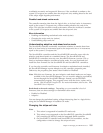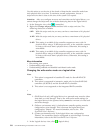
2. Right-click Change write-cache mode to write back or write through.
3. If you click write back and you do not have a battery-backup cache, click Yes
to confirm your choice because there is a risk of losing data.
If you click write back and you do have a battery-backup cache, the
ServeRAID Manager changes the mode.
If you click write through, the ServeRAID Manager changes the mode.
More information
v Understanding write-cache mode for logical drives
Changing the write-cache mode
Note: This action is not supported on enclosures with a dual controller
configuration.
Use this action to change the write-cache mode setting of all the physical drives in
an array. The write-cache mode determines if a physical drive stores data before or
after sending a confirmation to the controller.
Note: It is possible to lose data if a power outage occurs while using the
write-back setting. Consider carefully whether to use the write-back setting
on a physical drive. Depending on how you use the system, the write-back
setting might be undesirable.
1. In the Logical devices view, click
(array).
2. Right-click Configure write cache → write back or write through.
3. Click Yes to confirm.
More information
v Understanding write-cache mode for physical drives
Enabling and disabling read-ahead cache mode
Use this action to set the read-ahead cache mode to Enabled or Disabled. If the
read-ahead cache mode is set to Adaptive, you cannot use this action.
Note: You can override the Adaptive setting, but not through the ServeRAID
Manager. Instead, use the IPSSEND command-line program. This program is
on the IBM ServeRAID Support CD.
1. In the Logical devices view, click
(array).
2. Right-click Configure read cache → enabledor Configure read cache →
disabled.
3. Click Yes to confirm.
More information
v Understanding read-ahead cache mode
v Understanding adaptive read-ahead cache mode
Managing storage devices
Managing direct attached storage devices
Understanding FlashCopy backup: The FlashCopy function creates a quick
backup copy of data. It sets up a link between the source and target logical drives;
then, it creates a backup of the source data on the target drive. Any changes made
Chapter 4. Managing ServeRAID devices 197


















